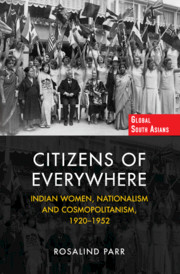Book contents
- Frontmatter
- Dedication
- Contents
- List of Figures
- Acknowledgements
- Note on Spelling
- List of Abbreviations
- Introduction: Cosmopolitanism, Nationalism and the Global Public Sphere
- 1 The Cosmopolitan-Nationalism of Sarojini Naidu
- 2 Suffrage; Solidarity
- 3 Becoming Global Citizens
- 4 Breaking America
- 5 A Changing World Order?
- 6 Defining Human Rights
- Conclusion
- Appendix 1 Dramatis Personae
- Appendix 2 The Universal Declaration of Human Rights
- Bibliography
- Index
5 - A Changing World Order?
Published online by Cambridge University Press: 06 August 2021
- Frontmatter
- Dedication
- Contents
- List of Figures
- Acknowledgements
- Note on Spelling
- List of Abbreviations
- Introduction: Cosmopolitanism, Nationalism and the Global Public Sphere
- 1 The Cosmopolitan-Nationalism of Sarojini Naidu
- 2 Suffrage; Solidarity
- 3 Becoming Global Citizens
- 4 Breaking America
- 5 A Changing World Order?
- 6 Defining Human Rights
- Conclusion
- Appendix 1 Dramatis Personae
- Appendix 2 The Universal Declaration of Human Rights
- Bibliography
- Index
Summary
Our nationalism may create trouble. Our narrow ideals may bring wars. Woman should therefore free man as well as herself of that narrow, sectarian idea and make him realise that he is not merely citizen of this country but citizen of the whole world.
In a photograph of the United Nations (UN) Sub-Commission on the Status of Women (SCSW) taken in May 1946, the group appears as a triumph of post-war internationalism. Seven women, dressed in contrasting styles, are seated amid the plush, 1930s-era facilities of Hunter College, New York. On the right of this tableau, Bodil Bergtrup, the Danish Chairman, addresses her colleagues. Beside her are Marie-Hélène Lefaucheux, a heroine of the French Resistance, Minerva Bernardino, the flamboyant feminist from the Dominican Republic, and Angela Jurdak, a Lebanese graduate of the American University in Beirut. On the corner sits the Polish diplomat Fryderyka Kalinowska, another survivor of Nazi occupation, next to the Chinese educator, Way Sung New. On the far left of frame, armed with an extensive file of ideas, is the All-India Women's Conference (AIWC) President and Indian nationalist activist Hansa Mehta (Figure 5.1). The image speaks of diversity, interconnection and a hopeful future – an international group of experienced, educated women representing the promise of universal gender equality in the new world order. After decades of struggle, women's rights had finally gained an official toehold in world governance. And it was a story in which Indian women leaders intended to play a leading role.
A few months earlier, in November 1945, Amrit Kaur led the Indian delegation at the Conference for the Establishment of the United Nations Educational, Scientific and Cultural Organisation (UNESCO) in London. The appointment of two well-known nationalist women as official representatives of India on the world stage was a sign of things to come. Within months, the Interim Government had assumed power in India under the leadership of Jawaharlal Nehru. A year later, the British had left. Nehru viewed the United Nations as a platform for establishing Indian credibility, including through the appointment of women to visible roles. This reflected one of the ways nationalist India sought to play a leadership role in the postcolonial world order.
- Type
- Chapter
- Information
- Citizens of EverywhereIndian Women, Nationalism and Cosmopolitanism, 1920–1952, pp. 115 - 134Publisher: Cambridge University PressPrint publication year: 2021



